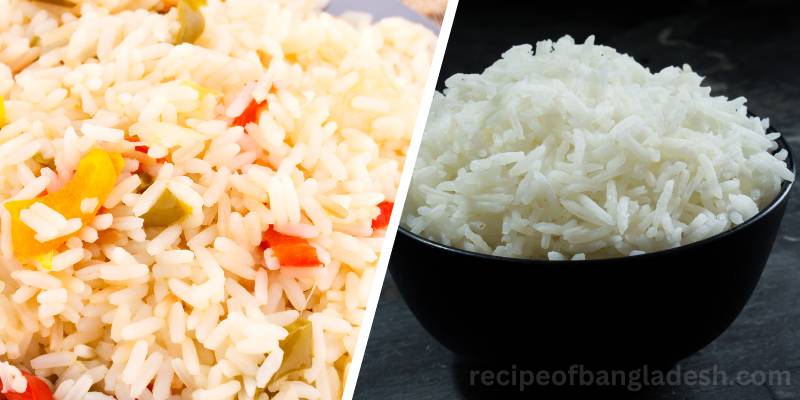Leftover cooked rice is very common in every household. It is very important for every home cook to know about the shelf life of cooked rice and how to properly store it in the refrigerator.
Understanding the shelf life of cooked rice is crucial to prevent food waste and maintain food safety. Proper storage can help extend the shelf life of cooked rice and reduce the risk of foodborne illnesses caused by consuming spoiled food. In this article, we will provide a brief overview of the factors affecting the shelf life of cooked rice and tips to store it correctly.

Factors that Affect the Shelf Life of Cooked Rice
Type of Rice
The type of rice can play a significant role in its shelf life. Different types of rice have varying levels of starch, which can affect their texture and spoilage rate.
Cooking Method
The way rice is cooked can also affect its shelf life. Rice that has been overcooked or undercooked may not last as long as properly cooked rice.
Temperature
Temperature is one of the most significant factors affecting the shelf life of cooked rice. Rice that is left at room temperature for an extended period can quickly become contaminated with bacteria and spoil.
Storage Conditions
Proper storage conditions, such as keeping the rice in an airtight container at the right temperature, can help extend its shelf life. Exposure to moisture, light, and air can speed up spoilage, so it’s essential to store cooked rice in a dry and dark place.
The Average Shelf Life of Cooked Rice
With Refrigeration
When stored correctly in a refrigerator, cooked rice can last up to five days. Keeping the rice at a temperature below 40°F can slow down the growth of bacteria and prolong its shelf life. Here in details guide about how long you can keep your cooked rice in the fridge?
Without Refrigeration
Without refrigeration, the shelf life of cooked rice is significantly shorter. It is generally recommended to consume cooked rice within two hours of cooking if it’s not stored in a refrigerator.
Prolonged exposure to room temperature can result in the rapid growth of harmful bacteria and make the rice unsafe to eat. It’s crucial to follow food safety guidelines and either refrigerate or discard cooked rice that has been left at room temperature for an extended period.
Read more about how long does cooked rice last without refrigeration?
Identifying Signs of Spoilage in Cooked Rice
Visual Indications
Cooked rice that has gone bad will often have visible signs of spoilage, such as discoloration, mold, or an off-texture. If the rice has a slimy or sticky texture, it’s best to discard it.
Olfactory Indications
The aroma of cooked rice can also indicate spoilage. Rice that has gone bad will often have a sour or rancid odor, which is a clear indication that it should not be consumed.
Taste Test
As a final test, take a small bite of the cooked rice to determine if it’s safe to eat. Rice that has gone bad will often have an off-flavor or a sour taste. If you suspect that the rice is spoiled, it’s best to err on the side of caution and discard it. Remember that consuming spoiled rice can lead to foodborne illnesses, so it’s essential to be cautious when checking for signs of spoilage.
How to Store Cooked Rice in Fridge?
When storing cooked rice in the refrigerator, it’s important to place it in an airtight container to prevent it from drying out and to prevent any bacteria growth. Cooked rice can be stored in the refrigerator for up to 4-5 days. To extend its shelf life, you can also freeze the cooked rice for up to 6 months.
Don’t let your cooked rice go to waste – learn the proper storage techniques today!
Proper Temperature
To extend the shelf life of cooked rice, it’s essential to store it at the right temperature. Keeping the rice in a refrigerator at a temperature below 40°F is ideal for maintaining its freshness and preventing the growth of harmful bacteria.
Proper Container
The type of container used to store cooked rice can also affect its shelf life. Using airtight containers can help keep the rice fresh and prevent contamination from moisture, light, and air.
How to Reheat Refrigerated Cooked Rice?
Reheating Guidelines
Reheating cooked rice correctly is also important for maintaining its freshness and preventing foodborne illnesses. It’s recommended to reheat rice until it reaches an internal temperature of 165°F to ensure that it’s safe to consume. Avoid reheating rice multiple times as this can reduce its quality and increase the risk of spoilage.
There are several methods to reheat refrigerated cooked rice:
- Microwave: Transfer the rice to a microwave-safe dish and sprinkle with a few drops of water to keep it moist. Cover the dish with a lid or plastic wrap and heat for 2-3 minutes, stirring once in between.
- Stovetop: Transfer the rice to a saucepan and add a small amount of water or broth. Heat over medium heat, stirring constantly, until the rice is heated through.
- Oven: Transfer the rice to an oven-safe dish and cover with aluminum foil. Heat in a preheated oven at 350°F for about 10-15 minutes, or until heated through.
- Steamer: Transfer the rice to a heat-proof bowl and place it in a steamer basket over boiling water. Cover and steam for 5-10 minutes, or until heated through.
Regardless of the method, it is important to stir the rice occasionally to ensure even heating and prevent the bottom from burning.
Final Thoughts
The shelf life of cooked rice can vary depending on several factors, but following proper storage and reheating guidelines can help extend its freshness and maintain food safety. It’s essential to be cautious and mindful of the signs of spoilage and to discard any rice that has been left at room temperature for an extended period.
In this article, I’ve discussed the average shelf life of cooked rice, both with and without refrigeration, and the factors that affect its shelf life, such as the type of rice, cooking method, temperature, and storage conditions. I’ve also covered the signs of spoilage, tips for storing cooked rice, and proper reheating guidelines.
Importance of Food Safety
Food safety is crucial for maintaining good health, and it’s essential to follow proper food storage and handling guidelines to reduce the risk of foodborne illnesses. By understanding the shelf life of cooked rice and following the tips outlined in this article, you can help extend the shelf life of cooked rice and ensure that it remains safe to eat.

Leave a Reply